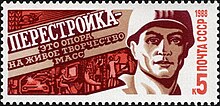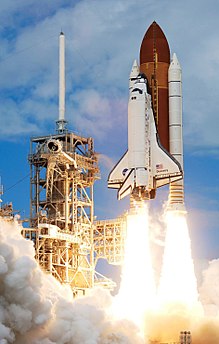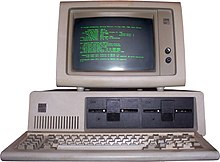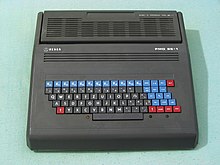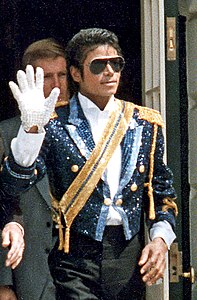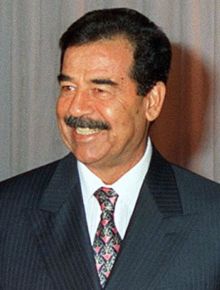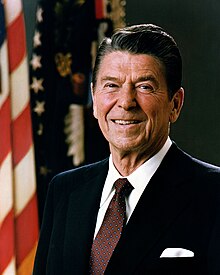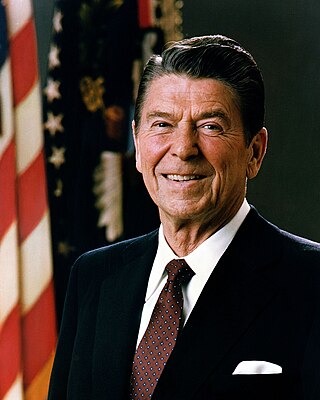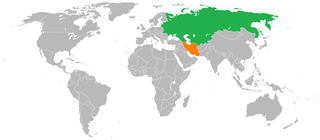Economics
World stock downturn
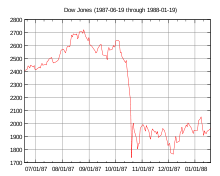
Black Monday (also known as Black Tuesday in some parts of the world due to time zone differences) was the global, severe and largely unexpected [1] stock market crash on Monday, October 19, 1987. Worldwide losses were estimated at US$1.71 trillion. [2] The severity of the crash sparked fears of extended economic instability [3] or even a reprise of the Great Depression. [4]
Possible explanations for the initial fall in stock prices include a nervous fear that stocks were significantly overvalued and were certain to undergo a correction, persistent US trade and budget deficits, and rising interest rates. Another explanation for Black Monday comes from the decline of the dollar, followed by a lack of faith in governmental attempts to stop that decline. In February 1987, leading industrial countries had signed the Louvre Accord, hoping that monetary policy coordination would stabilize international money markets, but doubts about the viability of the accord created a crisis of confidence. The fall may have been accelerated by portfolio insurance hedging (using computer-based models to buy or sell index futures in various stock market conditions) or a self-reinforcing contagion of fear.
The degree to which the stock market crashes spread to the wider (or "real") economy was directly related to the monetary policy each nation pursued in response. The central banks of the United States, West Germany, and Japan provided market liquidity to prevent debt defaults among financial institutions, and the impact on the real economy was relatively limited and short-lived. However, refusal to loosen monetary policy by the Reserve Bank of New Zealand had sharply negative and relatively long-term consequences for both its financial markets and real economy. [5]Reaganomics

Reaganomics ( /reɪɡəˈnɒmɪks/ ⓘ ; a portmanteau of Reagan and economics attributed to Paul Harvey), [6] or Reaganism, were the neoliberal [7] [8] [9] economic policies promoted by U.S. President Ronald Reagan during the 1980s. These policies are characterized as supply-side economics, trickle-down economics, or "Voodoo Economics" by opponents, [10] [11] including some Republicans, while Reagan and his advocates preferred to call it free-market economics.
The pillars of Reagan's economic policy included increasing defense spending, balancing the federal budget and slowing the growth of government spending, reducing the federal income tax and capital gains tax, reducing government regulation, and tightening the money supply in order to reduce inflation. [12]
The results of Reaganomics are still debated. Supporters point to the end of stagflation, stronger GDP growth, and an entrepreneurial revolution in the decades that followed. [13] [14] Critics point to the widening income gap, what they described as an atmosphere of greed, reduced economic mobility, declining real median wages, and the national debt tripling in eight years which ultimately reversed the post-World War II trend of a shrinking national debt as percentage of GDP. [15] [16]
Reagan was inaugurated in January 1981, making the first fiscal year (FY) he budgeted 1982 and the final budget 1989.
- During Reagan's presidency, the federal debt held by the public nearly tripled in nominal terms, from $738 billion to $2.1 trillion. [17] This led to the U.S. moving from the world's largest international creditor to the world's largest debtor nation. [15] Reagan described the new debt as the "greatest disappointment" of his presidency. [18]
- The federal deficit as percentage of GDP rose from 2.5% of GDP in fiscal year 1981 to a peak of 5.7% of GDP in 1983, then fell to 2.7% GDP in 1989. [19]
- Total federal outlays averaged of 21.8% of GDP from 1981–88, versus the 1974–1980 average of 20.1% of GDP. This was the highest of any President from Carter through Obama. [20]
- Total federal revenues averaged 17.7% of GDP from 1981–88, versus the 1974–80 average of 17.6% of GDP. [21]
- Federal individual income tax revenues fell from 8.7% of GDP in 1980 to a trough of 7.5% of GDP in 1984, then rose to 7.8% of GDP in 1988. [22]
Reagan policies

President Reagan's tenure marked a time of expanded economic prosperity for many Americans. The misery index sank to 9.72 from a high of 19.33, the greatest improvement record for a President since Harry S. Truman left office. [23] In terms of American households, the percentage of total households making less than $10,000 a year (in real 2007 dollars) shrunk from 8.8% in 1980 to 8.3% in 1988 while the percentage of households making over $75,000 went from 20.2% to 25.7% during that period. [24] However, the number of Americans below the poverty level did not decline at all. The number of children, ages 18 years and younger, below the poverty level increased from 11.543 million in 1980, 18.3% of children, to 12.455, 19.5%, in 1988. Also, the situation of low income groups was affected by the reduction of social spending, and inequality increased. The share of total income received by the 5% highest-income households grew from 16.5% in 1980 to 18.3% in 1988 and the share of the highest fifth of income increased from 44.1% to 46.3% in same years. In contrast, the share of total income of the lowest fifth of households fell from 4.2% in 1980 to 3.8% in 1988 and the second poorest fifth from 10.2% to 9.6%. [25]
In August 1981, after negotiations with the Republican-controlled Senate and the Democratic-controlled House, Reagan signed the largest marginal tax cut in American history into law at his California ranch. However, the 1981 marginal cuts were partially offset by bracket creep and increased Social Security rates the following year. [26]
Unemployment hit a low of 5.3% in 1988 after peaking at over 10% in 1982. [27] [28] [29] Real GDP growth recovered throughout Reagan's term, averaging +3.5% per year, with a high of +7.3% in 1984. [30] The average annual GDP growth during Reagan's presidency was the fifth highest since the Great Depression and the highest of any Republican president. [30] [31] Inflation decreased significantly, falling from 13.6% in 1980 to 4.1% by 1988, and 16 million new jobs were created. [32] The net effect of all Reagan-era tax bills resulted in a 1% decrease of government revenues (as a percentage of GDP), with the revenue-shrinking effects of the 1981 tax cut (-3% of GDP) and the revenue-gaining effects of the 1982 tax hike (~+1% of GDP), while subsequent bills were more revenue-neutral. [33] However, tax revenue itself nominally increased massively by 103.1% from 1981 through 1989, largely as a result of more loopholes abolished than tax rates lowered. [34]
During the Reagan Administration, federal receipts grew at an average rate of 8.2% (2.5% attributed to higher Social Security receipts), and federal outlays grew at an annual rate of 7.1%. [35] [36]
Reagan's administration is the only one not to have raised the minimum wage by its conclusion. [37]
Along with these, Reagan reappointed Paul Volcker as Chairman of the Federal Reserve, as well as the monetarist Alan Greenspan to succeed him in 1987. He preserved the core New Deal safeguards, such as the United States Securities and Exchange Commission (SEC), Federal Deposit Insurance Corporation (FDIC), the GI Bill and Social Security, while rolling back what he viewed as the excesses of 1960s and 1970s liberal policies.
These policies were labeled by some as "trickle-down economics", [38] though others argue that the combination of significant tax cuts and a massive increase in Cold War related defense spending resulted in large budget deficits, [39] an expansion in the U.S. trade deficit, [39] as well as the stock market crash of 1987, while also contributing to the Savings and Loan crisis. [40] The ultimate cost of the Savings and Loan crisis is estimated to have totaled around US$150 billion, about $125 billion of which was consequently and directly subsidized by the U.S. government. John Kenneth Galbraith called it "the largest and costliest venture in public misfeasance, malfeasance and larceny of all time". [41]
In order to cover new federal budget deficits, the United States borrowed heavily both domestically and abroad, raising the national debt from $997 billion to $2.85 trillion, [42] and the United States moved from being the world's largest international creditor to the world's largest debtor nation. [43] Reagan described the new debt as the "greatest disappointment" of his presidency. [44]
Reagan's support for an increased defense budget at the height of the Cold War was supported by Congressional Democrats and Republicans. However, Congress was reluctant to follow Reagan's proposed cuts in domestic programs. In accordance with Reagan's less-government intervention views, many domestic government programs were cut or experienced periods of reduced funding during his presidency. [45] These included Social Security, Medicaid, Food Stamps, and federal education programs. [46] Though Reagan protected entitlement programs, such as Social Security and Medicare, [47] in one of the most widely criticized [48] actions of the administration, the administration attempted to purge tens of thousands of allegedly disabled people from the Social Security disability roles, who the administration alleged were not truly disabled. [48] Funding for government organizations, including the Environmental Protection Agency, were also reduced. [49] He cut the EPA's budget by 22%, and his director of the EPA, Anne M. Burford, resigned over alleged mismanagement of funds. [50] Tax breaks and increased military spending created a larger budget deficit, which led Reagan to approve two tax increases, aiming to preserve funding for Social Security. [51] By 1988, it was reported that funding for the social safety net was down by 6 percent compared to two years prior. [52]
Speaking of Reagan himself, Donald Regan, the President's former Secretary of the Treasury, and later Chief of Staff, criticized him for his lack of understanding economics: "In the four years that I served as Secretary of the Treasury, I never saw President Reagan alone and never discussed economic philosophy or fiscal and monetary policy with him one-on-one. … The President never told me what he believed or what he wanted to accomplish in the field of economics." [53] However, Reagan's chief economic adviser Martin Feldstein, argued the opposite: "I briefed him on Third World debt; he didn't take notes, he asked very few questions. … The subject came up in a cabinet meeting and he summarized what he had heard perfectly. He had a remarkably good memory for oral presentation and could fit information into his own philosophy and make decisions on it." [54]